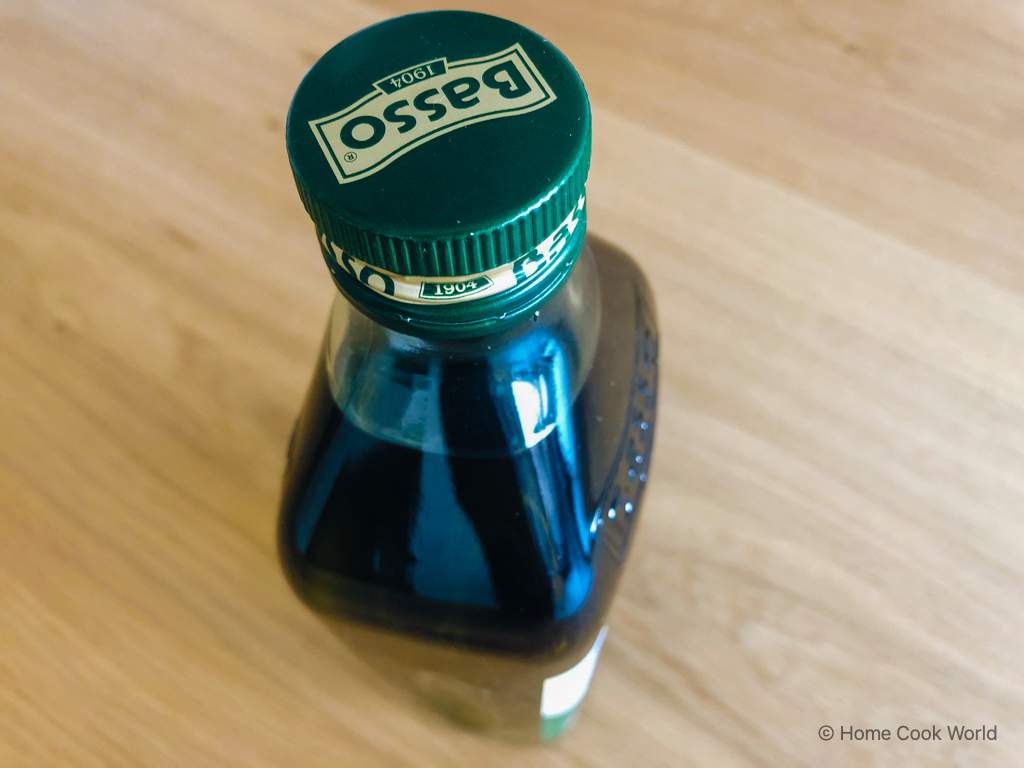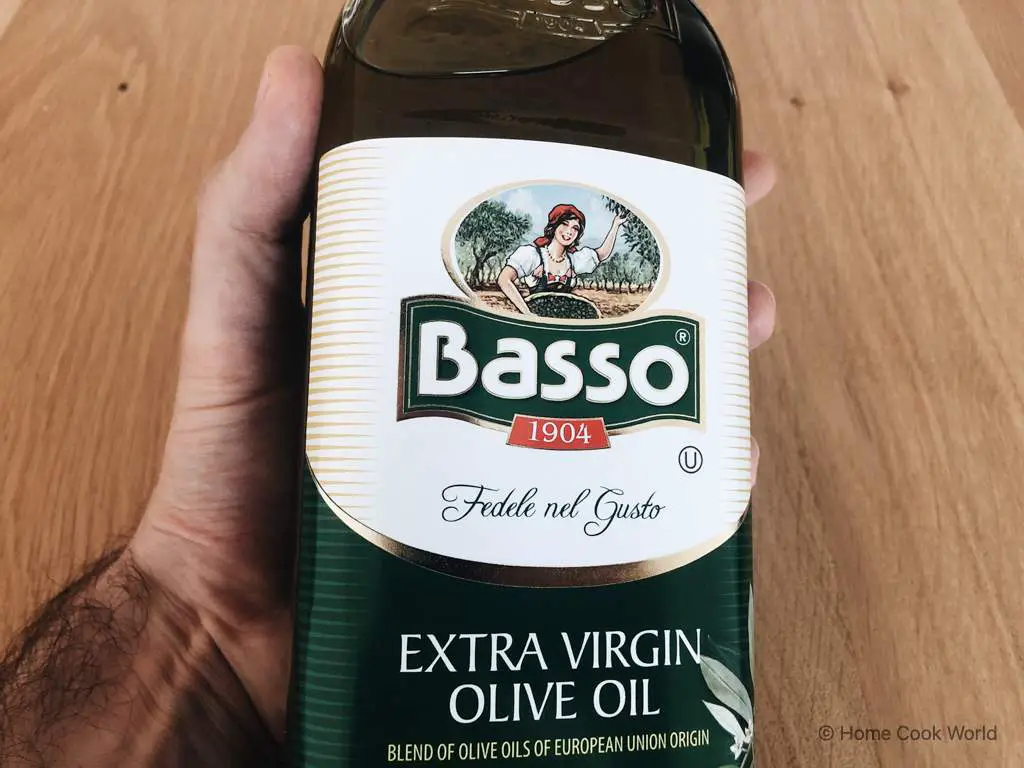Olive oil is my all-time favorite cooking oil. It’s aromatic, flavorful, and good for you. What more could you want from a cooking oil, really?
Yet good olive oil can be surprisingly hard to find. Especially if you don’t know how to choose olive oil for your home cooking. This is why, every now and then, I’ll be trying and reviewing different olive oils here on my blog.
In this post, I’m going to review Basso’s Classic Extra Virgin Olive Oil. If that’s what you came here for, then keep on reading.
Is Basso classic extra virgin olive oil good?
Basso Extra Virgin Olive Oil is an aromatic, flavorful, and slightly spicy extra virgin olive oil made from a blend of Italian, Spanish, and Greek olives. It’s definitely a great olive oil for your home cooking and, with its balanced profile, is very versatile in its use.
This oil has an earthy aroma of black olives and green grass. It has a fine and smooth texture and what I’d describe as a well-balanced bittersweet taste, which comes a little bit on the spicier side (without being overly aggressive). One thing that I really like about it is its long-lasting fruity aftertaste.
Drizzle this olive oil on top of seafood, pasta, or pizza. Make sauces, soups, and stews with it. Or season your salads and elevate your antipasti to the next level.
My score? Good value for the money.
It’s a balanced olive oil of good quality that gives you great value for the money. It can easily turn into the staple olive oil for most of your home cooking.
It’s also missing that je ne sais quoi that would allow me to give it a higher rating. Like a grainier, more viscous texture. Or a surprising aroma and something highly unique about the flavor.
It’s simply a high-quality, well-balanced olive oil that’s fit for most occasions. Which, at the end of the day, makes it a pretty good oil for home cooking. I just wouldn’t make spaghetti aglio e olio (spaghetti with garlic and oil) with it.
Look for Basso’s classic extra virgin olive oil in the Italian market or deli in town (or find it online). It’s sold mostly in 1l, 500ml, and 250ml glass bottles.
The glass is slightly tinted, as it should protect the olive oil from exposure to sunlight. Once opened, store it in a cool and dry place, ideally in your pantry or inside a kitchen cabinet.
What Olives Is Basso Extra Virgin Olive Oil Made From?
In general, there are two types of extra virgin olive oil: single varietal and blend.
Single varietal olive oils are made from one olive variety. Blend olive oils are made by mixing olive oils from several olive varieties to achieve a specific aroma and taste.
Some artisanal producers continue to make only single-variety olive oils, but most olive oils on the market today are a blend. Basso Extra Virgin Olive Oil is no exception.
Blending olive oils, just like making wine or whiskey, is a science and an art. Some producers do it better than others.
So let’s see where Basso stands.
Basso Extra Virgin Olive Oil is a blend of five types of olive oil from three countries in Europe: two types from Italy, two from Spain, and one from Greece.
The Italian olive oils in Basso’s extra virgin olive oil blend are Ogliarola and Coratina, both of which come from olives grown in Italy’s Puglia region.
The Spanish varieties are Arbequina and Hojiblanca, cultivated in Aragon and Andalusia for the first and Cordoba and Malaga for the second.
The Greek olive oil comes from Koroneiki olives, grown pretty much all over Greece. If you’ve visited Greece, most of the olive trees you’ll see as you walk or drive by olive gardens are Koroneiki olive trees.
Basso Extra Virgin Olive Oil has a balanced aroma and consistent, slightly peppery (nothing too crazy), taste.
It’s slightly more on the peppery side, but it comes off as the “classic” olive oil taste that most of the time you’re looking for.



Alternatives
Readers looking for a milder, less spicy extra virgin olive oil for a similar price can consider De Cecco Classico Extra Virgin Olive Oil. It’s cold-pressed from a selection of Mediterranean olives and, if you’re into olive oil, is definitely worth a try.
A creamier alternative—and others have emailed me to let me know that they agree—is Filippo Berio Extra Virgin Olive Oil.
Is Basso “Real” Extra Virgin Olive Oil?
Some producers will mislead you by labeling their olive oils as “virgin” or “extra virgin,” until you read the back of the label and find out that you’re getting a lesser-quality product than you think.
Is that the same for Basso’s classic olive oil?
According to the label, each of the five olive oils in Basso Extra Virgin Olive Oil’s blend is cold-pressed and obtained by only mechanical means. The factsheet also says that the oils were extracted at temperatures less than 80.6°F (27°C).
This makes Basso’s classic olive oil an authentic and real extra virgin olive oil as, during production, the olives weren’t heated to temperatures that lessen the flavor profile and nutritional value of the oil, nor was any olive oil extracted using chemical solvents.
All in all, you can trust that this olive oil consists of a quality blend of European oils for household use, which was processed correctly during production.
How I Pick Olive Oil (And the Rest of My Food)
Whenever I have a choice, I like to buy products from producers I trust.
Yes, trust is a personal thing and business is ultimately about making profit. So is the living I earn from running this blog. Yet there’s something that some companies have that others don’t—and that something is pride of craftsmanship.
Pride of craftsmanship leads to higher standards. Higher standards lead to better products. And, when it comes to your home cooking, better ingredients mean healthy and tasty food.
Humans are creatures of many biases, and I may be fooling myself here, but I’ve seen that pride of craftsmanship usually belongs to two types of companies: family-ran and local.
Local is easy. I go to the farmer’s market and shop mostly for locally grown vegetables and fruits. I buy dairy and meat from farms I’ve read about and whose owners I know in person, met at the market, seen on interviews, or read good things about in groups and forums.
I just like to know that I’m supporting local farmers and my local economy, you know.
Family-ran, on the other hand, doesn’t always mean local. On any day, I’d choose Italian food made in Italy by a family-ran company over food that claims to be Italian but is made elsewhere in Europe or the Americas.
For example, I like my canned San Marzano tomatoes for pasta sauce from Italy. When I want to grate a hard cheese on my pasta, I don’t go for a local rip-off but instead buy imported Parmigiano-Reggiano or Pecorino Romano with the European Union’s Protected Designation of Origin (PDO) label on it.
The same applies to olive oil. When it comes to olive oil, I like mine from two geographic areas: Greece, Spain, Portugal, and Italy in Europe and California in the U.S.
These regions on the two sides of the Atlantic tend to have the best conditions for growing great olives and producing great olive oil.
As you can probably guess, I like to research olive oil producers before buying and tasting their products.
So here’s what I found about the maker of Basso Extra Virgin Olive Oil.
Who Makes Basso Extra Virgin Olive Oil?
The long story short, you say?
Basso Extra Virgin Olive Oil is made by a family-owned Italian company with a century of history.
For the curious of you, here come the details.
Basso Extra Virgin Olive Oil is made by Basso Fedele e Figli S.r.l., an Italian olive oil producer and bottler.
The company’s history dates back one century to the year 1904. Felice Basso, who lived in the small town of Giffoni Valle Piana, sold oil from his hometown to Serino, in a village on the other side of the mountains.
At first, Felice marketed the oil in Serino and used mules to carry it across the mountains from his home village. Until he met the love of his life and moved, along with his company’s operations, to Serino.
The name Basso Fedele e Figli translates roughly as “Basso (the original) and his family.” The company continues to be owned by the Basso family to this date. It’s currently run by fourth-generation owner Sabino Basso.
When Sabino joined the family business, he tells Italianpreneurs, it was just him, his father and mother, and two employees. “One day, I get a letter from Belgium, of people who wanted to import my product, and there it was, that night I couldn’t sleep,” Sabino recalls for the Italian magazine.
“I thought strongly about export, and I thought of finally having a company with all the possible and imaginable trappings, a company with a capital C, so Dad’s company was a home and shop company: that is, underneath was the factory and above it was our home.”
Today, Basso Fedele e Figli produces, packages, and exports olive oil to 80+ countries worldwide and started building a new production plant in 2020. “The company now has already started with the fifth generation of my children, who work permanently in the company and are pursuing my philosophical thought.”
Conclusion
Basso Extra Virgin Olive Oil is a balanced olive oil that definitely has a place in your home cooking.
If you’re looking for that authentic and genuine European olive oil taste, this classic extra virgin olive oil blend from Italy, Spain, and Greece will give you great value for the money.
After trying it once, I can definitely say that I’ll be buying this one again. What about you? Did you get to try it? If yes, did you like it?
